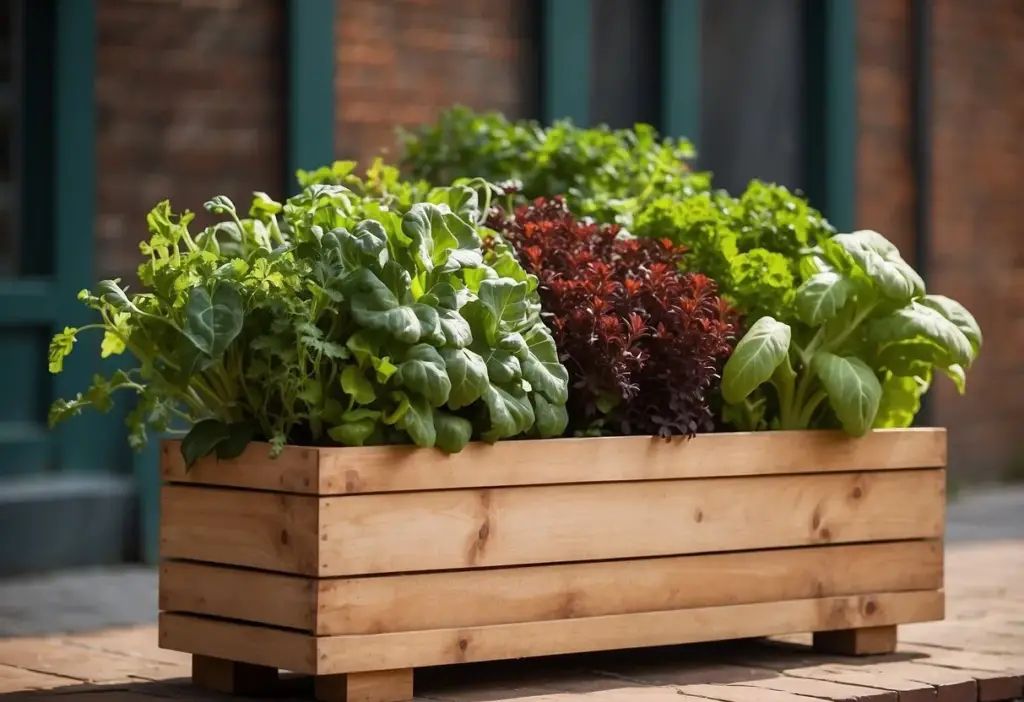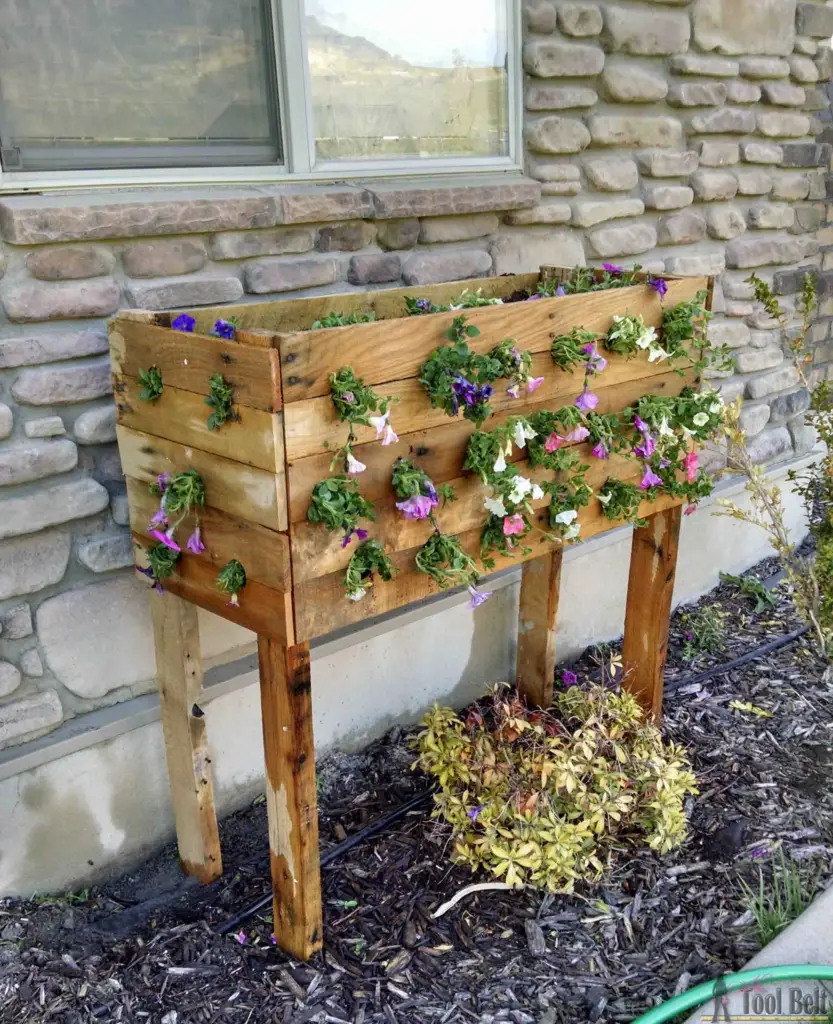
Even if you don’t have a large garden, you still want to raise your own veggies. For you, vertical vegetable planting might be the ideal answer. With this technique, you can use walls, fences, and other vertical structures to optimize your growing space. If you have the correct plans and resources, you can build a lush and fruitful garden in any area—your tiny backyard, your balcony, or even an interior space.
Vertical gardens are a visually pleasing and practical method to add greenery to your house. You may enjoy fresh produce without requiring a vast amount of land by growing plants vertically. You’ll discover a range of vertical vegetable garden designs in this tutorial, suitable for various areas and abilities.
Hanging Shoe Organizer Planter

Transforming a hanging shoe organizer into a planter is an innovative way to grow herbs and small vegetables in a compact space. Mount the organizer on a sunny wall or fence to ensure your plants get ample light. Opt for an organizer with deep pockets to accommodate soil and plants effectively. Secure it firmly to support the weight of the soil and growing plants. You can cultivate a variety of vegetables such as lettuce, spinach, and strawberries in this setup, making it a practical solution for limited garden areas.
PVC Pipe Vertical Garden

Creating a vertical garden using PVC pipes is a space-saving and efficient method for growing vegetables. Start with 4-inch PVC pipes as your main structure. Measure and cut the pipes to your desired lengths, then drill evenly spaced holes for planting. Place a weed barrier inside the pipes and fill them with soil. Incorporate an irrigation line through the center to ensure consistent moisture for your plants. This setup not only maximizes space but also simplifies watering and maintenance. Explore more detailed instructions to perfect your PVC pipe vertical garden.
Wall-Mounted Pot Rack Planter

A wall-mounted pot rack planter is an excellent solution for limited yard space. Hang pots on a wall or fence to keep your gardening area organized and visually appealing. Use hooks or a dedicated pot rack to support the pots, making it easy to grow herbs, small vegetables, and flowers. Experiment with various pot sizes to create a distinctive and attractive display. This vertical setup is ideal for sunny spots and simplifies watering and maintenance, making it a great addition to your garden.
Tiered Hanging Baskets

Tiered hanging baskets offer a practical way to grow a variety of vegetables while saving space. These baskets allow you to stack plants in multiple layers, creating a vertical garden that’s both functional and decorative. You can plant herbs, lettuces, or strawberries, which will thrive and enhance your space with vibrant greenery. Easy to install and maintain, tiered hanging baskets are perfect for small gardens or patios, helping you optimize your gardening space.
Garden Trellis Planter

A garden trellis planter is an ideal choice for growing climbing vegetables like tomatoes, cucumbers, or peas in small spaces. Attach a trellis to a planter box, allowing your plants to climb and grow vertically. This setup not only saves ground space but also makes harvesting more convenient. Choose a robust trellis that can handle the weight of mature plants. For more ideas on vertical gardening, explore various ways to integrate trellises into your garden design.
Gutter Garden

A gutter garden is a creative way to utilize vertical space for growing herbs, leafy greens, or strawberries. Mount rain gutters on a wall or fence to create this unique garden. Gutter gardens are perfect for small areas and are easy to water and maintain. With minimal effort, you can create a lush, thriving garden. For additional inspiration, check out DIY gutter garden projects to enhance your vertical gardening setup.
Pallet Planter

A pallet planter offers an eco-friendly option for vertical gardening. Recycle old wooden pallets by setting them upright against a wall or fence for stability. Add backing to the pallet using landscape fabric or a similar material to hold soil in place. Fill the pallet with soil and evenly distribute it before planting your vegetables. Herbs, lettuce, and strawberries grow well in this type of planter. For more guidance on creating pallet gardens, refer to detailed DIY instructions and ideas.
Tower Garden

A tower garden is an excellent way to grow vegetables in confined spaces by stacking pots or containers vertically. This method is suitable for patios, balconies, or even indoor settings. Build a tower garden using materials like PVC pipes or opt for pre-made kits. This setup maximizes your garden space and is straightforward to maintain, making it an ideal project for beginners. Explore various tower garden designs to find the best fit for your space and gardening needs.
Vertical Herb Garden Frame

A vertical herb garden frame is a stylish and efficient way to cultivate herbs. Construct a simple wooden frame and attach small pots or planters to it. This design not only conserves space but also adds a decorative element to your garden. Ideal for both novice and experienced gardeners, this project allows you to grow herbs like basil, thyme, and mint. Complete the setup over a weekend and enjoy fresh herbs year-round while making the most of small spaces.
Succulent Wall Frame

Incorporating succulent wall frames into your vertical garden is a creative way to save space. Build a frame using shallow wooden boxes and attach wire mesh to the front to support the roots of succulents. Line the frame with plastic to make it waterproof, ensuring durability. This setup is both visually appealing and functional, making it a great addition to your vertical gardening efforts.
Benefits of Vertical Vegetable Gardens

Vertical vegetable gardens maximize space, improve plant health, and simplify maintenance. By growing plants upwards rather than outwards, you can effectively utilize limited areas and enhance accessibility for gardening tasks.
Space Efficiency Vertical gardens are ideal for small spaces, allowing you to grow a variety of crops in compact areas. Techniques such as using trellises or stacked pots help you make the most of available space, perfect for urban gardens or small backyards.
Enhanced Plant Health Vertical gardening promotes better air circulation around plants, reducing the risk of fungal diseases and keeping soil-borne pests at bay. Additionally, vertical structures can provide partial shade, benefiting certain crops during hot weather.
Accessibility and Ease of Maintenance Vertical gardens make it easier to tend to your plants by reducing the need for bending or kneeling. This setup simplifies harvesting and reduces the risk of plants being hidden under foliage, making gardening more manageable and enjoyable.
Designing Your Vertical Vegetable Garden

Designing a vertical vegetable garden involves selecting the right location, structures, and plants. Each element contributes to creating a thriving and productive garden.
Choosing the Perfect Location Select a spot that receives 6-8 hours of sunlight daily and is close to a water source. Consider wind patterns and choose a location sheltered from strong winds to protect your plants.
Selecting the Right Structures and Materials Choose from various vertical garden structures such as trellises, pallets, or hanging planters. Ensure materials like treated wood or metal can withstand weather conditions. Use sturdy mounting hardware to secure your structures in place.
Optimal Plant Selection Select plants that thrive in confined spaces, such as leafy greens, herbs, and vine plants. Arrange plants with similar sunlight and water needs together and use trailing plants higher up to cascade down, maximizing vertical space.
Caring for Your Vertical Vegetable Garden

Proper maintenance of a vertical vegetable garden involves effective watering, soil care, and pest control strategies to ensure plant health and productivity.
Watering Techniques Use a drip irrigation system to provide consistent moisture. Water early in the morning or late in the evening to minimize evaporation, and use mulch to retain soil moisture. For wall-mounted gardens, consider self-watering planters for convenience.
Soil and Fertilization Tips Use a mix of high-quality potting soil and compost to ensure good drainage and nutrient availability. Incorporate slow-release fertilizers and use liquid fertilizers periodically to support plant growth. Regularly check for nutrient deficiencies and adjust fertilization as needed.
Pest Control Strategies Inspect plants regularly for pests and use physical barriers or organic pesticides to manage infestations. Encourage beneficial insects and use organic solutions like neem oil for safe pest control. Follow product instructions for best results.
